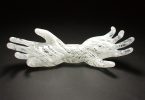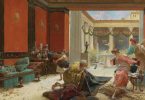The art of calligraphy that defies centuries, was introduced when the Turks met with Islamic faith, and reached its peak in the Ottoman region: “The Holy Koran was sent down to Hijaz, was read in Egypt, written in Istanbul.”
The meaning of the word “Hat” is writing, drawing, inscribing, and signing. The term can be defined as “The art of writing beautifully based on aesthetic criteria of Arabic writing.” In some sources, calligraphy is defined as the art of writing aesthetically and apprehensively, and due to this apprehension, the artists are called “calligraphers” and not “clerks” which reveals the major distinction. This aesthetic emerges as the letters of the Arabic alphabet are written differently in the beginning, in the middle, and in the end. This way the concepts of art, eternity and novelty manifest in different forms every time.
ART OF CALLIGRAPHY IN OTTOMAN
The calligraphy was seen on the historical scene in the early periods of Islam. In this period, the writings consisted of simple lines is called a “makili”. Later, this writing style was developed and “kufi” writing emerged. Today’s “sülüs” and “nasih” was formed by Ibn-i Mukle because it is difficult to write kufi. Ibni Bevvab and Yakut-i Mustasimi made these writing styles more aesthetic. With Turks’ adoption of Islam, calligraphy, an art discipline from Arab geography, has acquired a different dimension with Turkish culture. Turks, who changed the alphabet in official and literary language, introduced many forms to Islamic writing art and greatly contributed to it throughout the centuries. This writing style, which has a special place in Islamic arts, caught the most rapid development pace in the Ottoman geography. With Sultan Mehmed’s conquest, Istanbul became the capital of the art of calligraphy, so to speak.
The first known Turkish calligrapher in the 13th century was Yakut el Mustasami of Amasya. Sheikh Hamdullah was the figure that gave direction to Turkish calligraphy. Bayezid II took Sheikh Hamdullah under his protection and brought him to Istanbul, and the Ottoman traces in calligraphy became a school that would last for centuries. Sheikh Hamdullah rearranged six writing styles referred to as “aklam-ı sitte” in art of calligraphy.
Ahmet Karahisari is the most important calligrapher of this art that lived its golden age in the Ottoman lands in the 16th century. He introduced a different dimension by making innovations in the technique of calligraphy art. In the 17th century, Hafız Osman Effendi made sülüs and nasih writings more elegant. Today, the Holy Koran he wrote with calligraphy are still preserved in many Islamic countries. Born in the 17th century, calligraphy is survived in Turkish-Islamic arts without losing its importance.
FROM INK TO INKSTAND
In calligraphy, a reed pen is used for writing. Pens vary according to different writing styles. Bamboo or spear pens are preferred for large writings, reed pen for fine, and cava pen for the Holy Koran. Calligraphers have always shown respect to their instruments. The calligraphers who save the chips they cut fixing the tip of the reed, will to burn these chips to heat the water, used to wash their before their funerals.
To sharpen and straighten the pen’s tip, a knife type called a sharpener with a handle made of bone, ebony, agate or coral tree, is used. The tip is held with the left hand and sharpened with a sharpener. “Makta” is the instrument on which the pen is laid during the sharpening of the tip of reed pen. Generally bone, ivory, mother-of-pearl or horn is preferred for makta. The reason why these materials are preferred is to prevent blunting of sharpener’s cutter part. Adjustment of pen tip according to different writing styles requires skill. Because sharpening the tip with a different angle affects writing. A slit called a “şak” is left at the tip of the reed pen which allows more ink into the pen. Inkstand is a box made of glass or earth that preserves the ink, and lika. “Lika” is placing ruffled raw silk into the inkstand before ink. Lika helps getting sufficient ink on tip of the reed.
To perform calligraphy, calligraphers prefer a treated paper called “aharlı” paper which makes it easier to write. “Ahar” is the material used to make paper manageable and robust. Ahar is obtained from starch pudding or egg whites curdled with alum. The process is completed when the liquid material obtained is applied to paper surface. In this way the paper attains a brighter appearance. The ink’s consistency on the paper is perfect and this also facilitates erasing. A calligraphy on aharlı paper can be preserved for centuries. Calligraphy which unveils a rare art with materials used from ink to inkstand, from makta to lika, will continue to survive in the Turkish-Islamic arts by developing.
ON ART OF CALLIGRAPHY…
Prof. Uğur DERMAN
Among the scripts used in the world, the following two are shown as having the highest aesthetic appeal:
1- Islamic letters of Arabic origin,
2-Far East (Chinese / Japanese) letters
The Far Eastern letters are composed of numerous individual forms which do not join with each other and are written by brush. Depending on pressure of the brush, thin / thick lines are drawn.
The form of Arabic letters vary according to their position in the word, at the beginning, middle, or end. The tip of reed pen used in writing is fixed, and the fineness and thickness of letters are passed on the paper through position of the hand holding the pen.
The ink used in calligraphy is prepared by pounding substances which produce soot when burnt (such as beeswax, linseed oil, gas oil) with molten Arabic gum for a long period of time, and this is called “soot ink”.
The rectangle shape written on paper with reed pen is accepted as “the point”. The height, width of letters and their distances to each other are determined by point scale. The perfect scale was reached throughout the centuries, and the aesthetics of calligraphy was achieved. The calligraphy art has invariably had an upward trend in time.
The writing varieties arose from different approaches, were identified by their distinct processes: Sülüs, nesih, muhakkak, reyhânî, tevkı’, rıka, ta’lîk, dîvânî, celî dîvânî… The writings large enough to be read from afar, written by a wide-tip pen, are termed as “celî” as celî sülüs, celî ta’lîk… Celî dîvânî used in official correspondence, is named because of its intricacy.








Leave a Comment